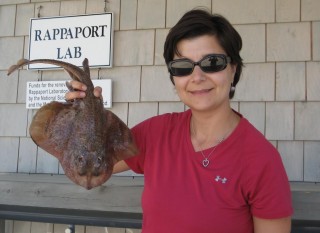Fish Colon Offers Insight Into Evolution

Nicole Theodosiou uses these skates, cartilaginous fish related to sharks and rays, to learn how we came to have colons.
“I’m particularly interested in how land animals stay hydrated, even though we don’t have a hard shell that prevents us drying up like raisins in the sun,” she said. “The colon is an important organ that helps us retain and absorb water, but how exactly did we come to have this organ?
The skate has begun to provide an answer.
As a marine creature that hasn’t changed in 450 million years, the skate is a living fossil that provides a snapshot of what animals were like a very long time ago. It’s also a fish that’s isotonic with its environment, meaning concentrations of things like salt inside its body are in exact balance with concentrations outside its body (in the ocean it lives in).
As a result, the skate is never thirsty or in danger of not getting enough to drink. But – intriguingly – it does have a rudimentary colon that soaks up water, as Theodosiou and her colleagues learned.
“Fish aren’t supposed to have the ability to absorb water in their intestines, they don’t really need to,” she explained. “The fact that skates do absorb water, and have the cell types and water channels to facilitate water absorption, means that animals were potentially ‘primed,’ in a way, to survive on land.”
“That’s new,” Theodosiou continued. “People think that animals move to a new environment and they evolve to survive. But maybe sometimes in evolution you need to be ready to accept the change that comes.”
Contact Information
Phillip Wajda
Director of Media Relations
wajdap@union.edu
Phone: 518-388-8394
Mobile: 518-857-8601
Media Contact
All latest news from the category: Life Sciences and Chemistry
Articles and reports from the Life Sciences and chemistry area deal with applied and basic research into modern biology, chemistry and human medicine.
Valuable information can be found on a range of life sciences fields including bacteriology, biochemistry, bionics, bioinformatics, biophysics, biotechnology, genetics, geobotany, human biology, marine biology, microbiology, molecular biology, cellular biology, zoology, bioinorganic chemistry, microchemistry and environmental chemistry.
Newest articles

Webb captures top of iconic horsehead nebula in unprecedented detail
NASA’s James Webb Space Telescope has captured the sharpest infrared images to date of a zoomed-in portion of one of the most distinctive objects in our skies, the Horsehead Nebula….

Cost-effective, high-capacity, and cyclable lithium-ion battery cathodes
Charge-recharge cycling of lithium-superrich iron oxide, a cost-effective and high-capacity cathode for new-generation lithium-ion batteries, can be greatly improved by doping with readily available mineral elements. The energy capacity and…

Novel genetic plant regeneration approach
…without the application of phytohormones. Researchers develop a novel plant regeneration approach by modulating the expression of genes that control plant cell differentiation. For ages now, plants have been the…





















